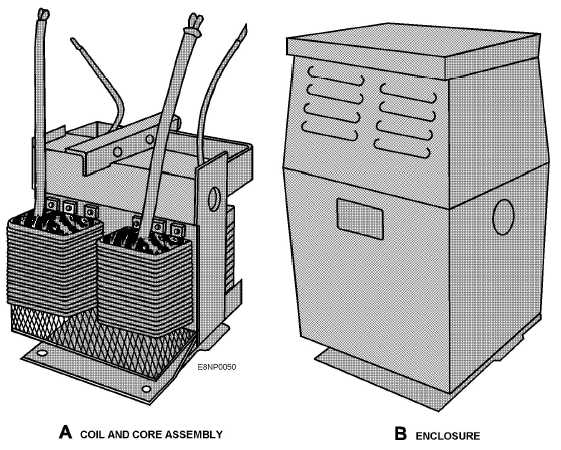When a transformer is used to step up the
voltage, the low-voltage winding is the primary.
Conversely, when a transformer is used to step
down the voltage, the high-voltage winding is the
primary. The primary is always connected to the
source of the power; the secondary is always
connected to the load. A common practice is to
refer to the windings as the primary and
secondary rather than the high-voltage and low-
voltage windings.
Two principal types of transformer construction
are the core type and the shell type (fig. 3-15,
views A and B). The cores are built of thin
stamping of silicon steel. Eddy currents, generated
in the core by the alternating flux as it cuts
through the iron, are minimized by using thin
laminations
and
by
insulating
adjacent
laminations with insulting varnish. Hysteresis
losses, caused by the friction developed between
magnetic particles as they are rotated through
each cycle of magnetization, are minimized by the
use of a special grade of heat-treated, grain-
oriented, silicon-steel laminations.
In the core type of transformer, copper
windings surround the laminated iron core. In the
shell-type of transformer, an iron core surrounds
the copper windings. Distribution transformers
are generally of the core type, whereas some of the
largest power transformers are of the shell type.
Transformers are built in both single-phase
and polyphase units (fig. 3-16). A three-phase
transformer consists of separate insulated
windings for the different phases, which are
wound on a three-legged core capable of
establishing three magnetic fluxes displaced 120°
in time phase.
POLARITY
MARKING OF POWER
TRANSFORMERS
It is essential that all transformer windings be
properly connected and that you have a basic
understanding of the coding and the marking of
transformer leads.
The leads of large power transformers, such as
those used for lighting and public utilities, are
marked with numbers, letters, or a combination of
both. This type of
Figure 3-16.-Single-phase transformer A. Coil and core assembly B. Enclosure.
3-11


